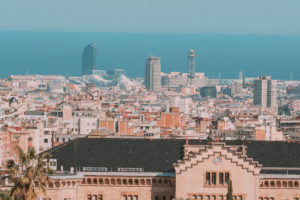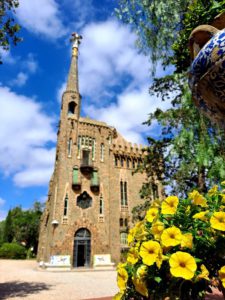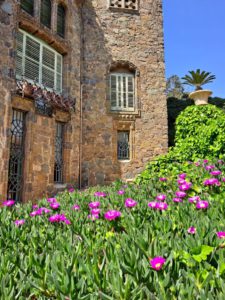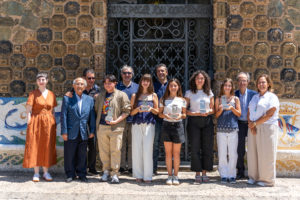March 22, 2024
By: Ferran Garcés
Yesterday was the beginning of spring. Torre Bellesguard is an ideal place to enjoy it, thanks to the surrounding nature. Let’s remember that it is located at the foot of the Tibidabo mountain and is surrounded by a garden also designed by Gaudí. Moreover, the history of the property, full of legends and historical events, shapes another symbolic garden, which has served as inspiration not only to the architect but also to poets…
The original garden
In the early 15th century, King Martí I the Humane chose this place to build a castle more for rest than for defense against a siege. Consequently, the lands dedicated to the garden and orchard received special attention. The letters where the monarch requested grafts of fruit trees from different parts of his kingdoms, such as pears, apples, and grapes, as well as expert gardeners to care for them, have been preserved. (1)
The final result of so many shipments was perfectly summed up in the word Bellesguard, “Beautiful View,” which is the name the king himself chose to call that landscaped palace, on the advice of his chief advisor, Bernat Metge, one of the first great writers in the Catalan language.

Martí I died in 1410. More than a century and a half later, in 1589, a chronicler from the city of Barcelona, Jeroni Jorba, described the ruins of the castle and still highlighted that it had “a very beautiful garden.” (2) In the subsequent centuries, the estate would undergo various vicissitudes, either due to war or gradual abandonment. However, the memory of that idyllic garden/orchard will remain in the city’s memory.

A poetic garden
In the early 18th century, the ruins of the medieval castle were rebuilt by Joan Gualbes i Copons, one of the most renowned poets of the Baroque period in Catalonia. He was also a patron who organized various cultural gatherings at his Bellesguard palace, such as poetic Olympic games. (3)
Jacinto Verdaguer, a personal friend of Gaudí, will not forget Bellesguard in his Ode to Barcelona, written in 1883, stating that “From Bellesguard, perfumes remain.” The poet will evoke Martí I’s garden-castle again in 1900, the year Gaudí began planning and building Torre Bellesguard. He will do so in his poem, La Custodia, where he establishes two wordplays related to spring. (4) The first with the expression “blooming like an Easter,” which refers to the Resurrection Easter feast, a festivity that, as befits spring, is also known as “Flowery Easter.”
“Bellesguard is joyful, green, and blooming,
blooming like an Easter, green as April,
for knights and ladies, virgins and children.”
The second wordplay is with the name of Margarita de Prades, King Martí’s second wife and owner of the palace after her husband’s death. In fact, Martí and Margarita’s wedding took place in that fabulous garden, surrounded by flowers and fruit trees.

Margarida de Prades
“King Martín walks through the orchard:
here he sees a rose, there a carnation,
and further away a branch of orange.
But a Margarita has stolen his heart,
daughter of a beloved count, granddaughter of a king.
Margarita de Prades is his wife.”
A garden we can still enjoy
Just like in Martí I’s time, the first family of Torre Bellesguard owners, the Figueras, also wanted a good garden-orchard. Thanks to one of their descendants, we know, for example, that María Sagués, the matriarch, “was very fond of making jams and preserves.” That is why fruit trees were planted, “such as pear trees, bitter orange trees, lemon trees, etc.,” and other trees and plants, such as “Indian chestnuts, willows, oleanders, laurels, linden trees, palm trees.” (5) The second family of owners, the Guilera, have preserved much of the original garden, so some of those trees and plants are still there.



Consequently, during the Markets of Torre Bellesguard, the same oleander planted in Gaudí’s time serves as a backdrop for the musicians, and the linden trees at the entrance provide shade for the tables and hammocks. For more information about the Markets, open the following links: BCN en las Alturas and EAT GAUDÍ. Undoubtedly, the best time to enjoy spring. The best moment and the best place, a landscape that has experienced more than six hundred springs! Will you miss it?…
Notes
(1) Vall i Comaposada, Josep M. (2014), Bellesguard. From the residence of Martín the Humane to Gaudí’s Tower, Duxelm editorial, Barcelona, p. 51-52. The original letters in Annex II, p. 143-149
(2) Galindo, Esteban (29/04/2018), “The chronicler Dionís Jeroni Jorba,” Diari el Jardí website. Link
(3) Garcés, Ferran (27/07/2023), “The Olympic Games of Barcelona before 1992,” in Torre Bellesguard’s blog: Link
(4) Codina i Valls, Francesc (2006), Jacinto Verdaguer. Barcelona. Texts for a book, Verdaguer editions, Flogueroles, p. 160-162
(5) Figueras i Bas, Josep Mª (2016) The Figueras family. The lords of Bellesguard, self-published work, Barcelona, p. 68




